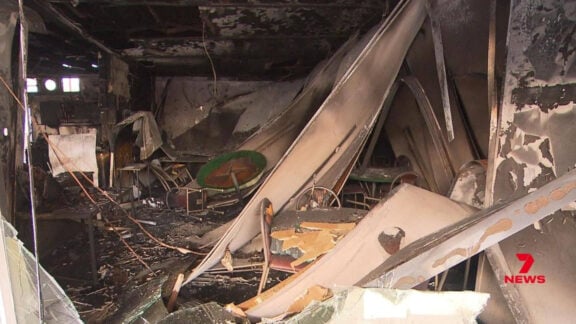Rain records have been smashed with a Victorian town recording three months worth of rain in 24 hours, as other regional areas are ordered to evacuate rapidly rising floodwaters.
People in Seymour and Yea in the Goulburn Valley were told to leave about midday Monday in an emergency warning.
“If you choose to stay, emergency services may not be able to help you,” the alert warned.
About 50 homes in Seymour are at risk of being flooded and another 140 could be isolated as a seven metre flood peak is expected on Monday afternoon.
Flood evacuation orders are in place in regional Victoria as heavy rain lashes south-east Australia. (William Ton)
Relief centres have opened at Seymour Sports and Aquatic Centre and Yea Shire Hall with centres in Bendigo, Echuca and Rochester popping up.
Central, north central and eastern parts of the state have been put on alert for the rest of Monday, with a major flood warnings issued for the Campaspe River near Bendigo.
Emergency crews made more than 38 flood rescues in Victoria in the 24 hours to 10am on Monday, bringing the state’s total flood rescue count to 58 since January 1.
There were 920 calls for assistance to VICSES over the same period for flooding, trees down and building damage, bringing the total to 1200 since 7pm Sunday.
“Cars don’t float for very long and they end up causing serious risk to people in them and can potentially cause loss of life,” Emergency Management Commissioner Rick Nugent said.
EMERGENCY WARNING – RIVERINE FLOOD – Evacuate Immediately – Yea
This Emergency Warning is being issued for Yea . If you live, work or are holidaying in this area, you should Evacuate Immediately if safe to do so.
More details at VICSES NEWS
Flash flooding occurred in the state’s southwest while more than 180mm of rain was recorded in the central Victoria town of Heathcote, amounting to three months worth in 24 hours.
Redesdale’s more than 117mm in 24 hours was a daily record for any month from 120 years of data. The 92mm recorded in Bendigo broke 90 year records.
Towns in central Victoria endured an intense 24 hours as the region faced its fourth major rain event since Christmas, the City of Greater Bendigo’s acting chief executive Brian Westley said.
“We’ve got very saturated grounds, we’ve got full water catchments and we’ve got full river systems. So further rains will result in some level of flooding,” he told AAP.
About 30 homes in Goornong, about 30km northeast of Bendigo, and six homes in Redesdale have been evacuated after water inundated the properties.
“Depending on how today evolves, we are anticipating potentially 30 families from the Goornong area may find their way to the emergency relief centre,” Mr Westley said.
The focus now turns to other areas across the state as more flooding is expected over the next 24 to 72 hours, VICSES chief operations officer Tim Weibusch said.
Up to 35 houses face being flooding and another 250 could be cut off in Rochester as floodwaters are expected to reach 114.8m on Tuesday.
Kialla, Mooroopna and nearby Shepparton are on alert for minor to moderate flooding.
Wangaratta and Echuca are also at risk of flooding in coming days.
People in metropolitan Melbourne are urged to avoid bike and walking paths near the Maribyrnong, Yarra and Bunyip rivers.
Widespread rain has affected water quality as road dirt and grease, animal faeces and vegetation make their way into the Victoria’s waterways and increase the risk of gastro or skin rashes.
Today’s primary hazard is localised heavy rainfall and possible flash flooding, with the additional risks of damaging winds & large hail. @BOM_NSW
The trough is expected to move east into southeast NSW on Monday and continue along the coast over the coming days bringing heavy rainfall, Bureau of Meteorology’s Miriam Bradbury said.
Sydney, the Illawarra and Newcastle should expect moderate to local heavy falls on Tuesday, although they’re likely to be tied to thunderstorm activity.
“That rain will contract to the north into northeast NSW and southeast Queensland, areas which are still in cleanup and recovery mode from previous rain events,” Ms Bradbury said.
In South Australia, flooding risk in the Flinders Ranges have reduced and creek water levels are dropping despite being higher than normal.









